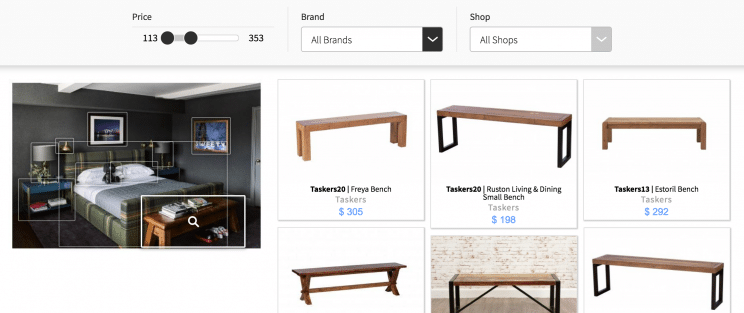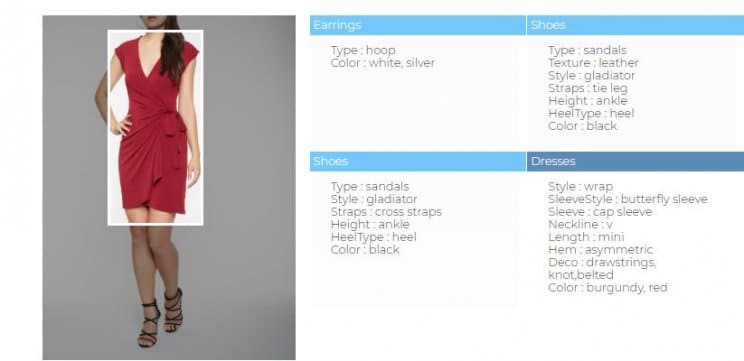The last quarter always opens the floodgates for predicting trends for the new year. While some of them will be true, many will be fleeting, and most will be more speculative than actually predictive.

So before this deluge comes, it’s time to look at something that is actually clear: visual search is building in strength and relevance, especially for ecommerce.
Yes, Syte is a visual search company, but this isn’t just our opinion. Major ecommerce players have all adopted or launched features that rely on visual search or image features. New reports are predicting more consumer reliance on the image when it comes to ecommerce, and data from existing implementations shows avid consumer adoption.
Far from being souped-up hype for 2019, visual search is a tool that’s been waiting in the wings and is finally making its big debut. Don’t wait for year-end lists to find out what early adopters already know: visual search is not only here to stay, but it’s the cornerstone of the next age of ecommerce.
Emerging advantages
The fact of the matter is that text search has always been inadequate when it comes to describing images. Users are attempting to put visuals into words, while machines are trying to figure out what the heck an image shows, and pairing the two has traditionally been a bit of a nightmare for everyone involved.
Visual search has already proven that it can overcome these hurdles because it takes out the middleman. Users don’t have to describe what they’re looking for; they can upload an image that’s similar and get perfectly matched results back. That’s a huge step from image to text to text back to image. Relying on visual search, instead of text search, helps consumers in three primary ways.
Speed
The mental gymnastics that customers have to do to find items that match their specifications through normal text search functions, and the poor results returned, add more time than you might think to a customer’s journey. Anyone who has ever tried to find a jacket, a pair of shoes or a barstool that matches what they see in their mind’s eye can attest.
With visual search, your customers can find what they want up to 5x faster than with text search. And in an age of unlimited online shopping options, getting quickly to an item a customer actually wants to purchase can make the difference between a sale and a site abandonment.

Taskers’ visual search tool instantly shows shoppers items that match items from a reference photo.
The truth is that text search, even with all the filtering and the auto-suggestions, doesn’t get consumers straight to what they need. Visual search better mimics an intuitive experience, like when a customer walks into a store and goes straight to a salesperson to find the item they are looking for.
Ease
When it comes to ease of use and UX, visual search is first in its class. It makes discovery a no-brainer because people can easily rely on all of the reference images we use when shopping. The beautiful magazine spread, the influencer’s blog post, the photo you took of an antique chair at a flea market — anything a consumer collects around them can instantly be used to find what they’re looking for.
Because of this, consumers take to visual search like a duck to water. Pinterest’s visual search feature saw a 140% YoY growth in the past two years, for example, exactly because it was so easy-to-use and got searchers to the items they wanted to shop for with extremely low hassle.
Consumer Desires
The consumer of 2018 — and their 2019 counterpart — relies heavily on images to shop and search, and this has only grown:
- Nearly 30% of all searches on Google are now image searches.
- 69% of young consumers show an interest in making purchases based on visual-oriented searches.
- An estimated 1.2 trillion digital photos were taken in 2017, many on smartphones and tablets.
- 75% of consumers report that they are inspired by images and videos while on their purchasing journey.
A big piece of this puzzle is the proliferation of smartphones, which account for at least 85% of digital photos.

[
Source]
When consumers are relying this heavily on photos, and when photos, screenshots and video content are so easily available, it makes sense that they would want to be able to easily shop using these images. Humans love visuals; we always have and we always will. Our technology is just now catching up to our love for them — and this what differentiates image technology from other trends.
State of early adoption
Many big ecommerce companies and apps have already adopted visual search and associated image technology. Some of the major players on the scene right now are:
- eBay, including mobile visual search options
- Amazon, including instant camera search on mobile
- Pinterest, including smart tagging and visual search
- Boohoo, including visual search on website
- ASOS, including visual search on app
- Intu, including visual search on website
- Kohl’s, including visual search on website
- Vivino, including instant camera search on mobile
- Wayfair, including visual search on website
- Taskers, including visual search on website
These companies are benefiting from early adoption in a number of ways. First, they have the distinct advantage of being able to test, tweak and collaborate on their search functions. eBay and Pinterest have been experimenting with visual features to augment their users’ journeys for long enough that they’re starting to figure out an integrated formula for visual search success.

eBay’s integration of a photo button on mobile makes it easy for shoppers to find items they have saved as images on their phones.
Sites like Boohoo and Intu are taking advantage of the ability to test and measure user behavior by rolling out image search for beta users or for certain sections of the website, so they can tweak their offering to best fit how customers use their tools.
Gartner predicts that early adopter brands that support visual and voice search will increase ecommerce revenue by 30% come 2021, and this ability to test and tweak is important. Rather than scrambling to roll out a fully realized version of a product that’s perfectly tailored to users who already expect visual search, they can work with their partner company to maximize custom solutions for their users and their company’s needs.
Every quarter, more and more companies are adopting this tool because it’s rapidly becoming an industry standard. Waiting until after the trend predictions of 2019 play out might be too late where visual search is concerned.
Current use cases
Beyond the visual search for website and mobile that so benefits consumers, visual search technology has a huge potential to upgrade other aspects of ecommerce businesses.
One thing that might surprise you is that the same tech that visual search relies on can actually be used to improve your text search — you heard that right, visual tech can improve that same old text search everyone hates. Take Syte’s enhanced textual search, which is based on image deep tagging.
Instead of relying on teams of human taggers to go through and categorize items, the same AI that makes image search possible can add any number of tags to any piece of inventory, allowing for more accurate search results using text alone:

This type of tagging capability can also boost an ecommerce company’s back-end process for sorting goods. Using an image alone, a company can create a CSV file of their inventory. And when AI can differentiate between shiny and glossy with consistency and accuracy that is superior to manual taggers, this means faster inventory results with better sorting.
For a company like Intu, which sells items from third parties and often only has product images to go off of, this makes a huge difference both for the time it takes them to sort through items and the time it takes customers to find what they want.
Ready or not… here it comes
What 2018 has proved for ecommerce is that visual search is here to stay. No matter what else is predicted for 2019, image search is going to be on the menu. And believe it or not, what we’ve covered here isn’t even all of what visual search can do.
If you’re looking to implement visual search this quarter, the next, or in 2019, contact Syte to see how we can partner with your business.